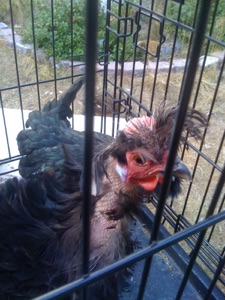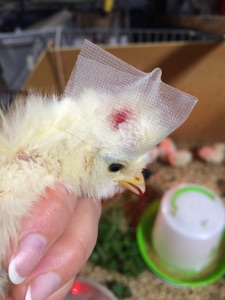
Crest Picking in Polish
It’s happened to all of us who raise Polish. One day our bird looks great, with a full, wonderful crest to admire. The next day, it’s a bloody mess. Here are some of my thoughts on how I like to handle this. I think there are several factors that enter into this behavior:
1- Temperament- bullying- you can see it in the brooder- one chick that just pick pick picks at all the others. Usually, I will immediately cull such a chick. I found that I did this a lot in my early years of breeding Polish and now I rarely need to- I think because some of that behavior is genetic and I have removed it from my gene pool. If I REALLY need to keep a certain bully chick because it looks like one of the best I’ve bred, I’ll try moving it to a brooder with older chicks, so it gets a little taste of bullying itself. Same thing if I have an adult bird that is a bully. I’ll sell it, cull it, or try to move it to another pen with tougher inmates.
Crest picking also happens in a non-bullying situation where it is part of sexual grooming. The female who loves her mate shows this devotion by plucking him bald. The boy just sits next to her on the roost, gazing at her with adoration, and lets her pluck him bloody. (Numerous similar situations in human relationships occur to me, but I digress.) I will tape these boys immediately. Usually this works. Sometimes the girl is relentless, starting in below the tape until there are no feathers left to tape to. These females will never stop. They must be housed separately from males or sold to a pet household where there are no males. It’s too bad, since these have often been some of my best hens but, again, this behavior seems to be genetic so, if you don’t want to keep perpetuating it, let them go to single sex non-breeding households.
2.- Crowding- Put too many chicks or adults in too small an area and picking is bound to occur. (Think of your last Thanksgiving dinner where all the family came over- whoops- digressing again.) You have two choices here. Build more pens- a lot more pens. This is a solution that appeals to me and I envy those of you who can pursue it. My husband says the place already looks like we’re red necks from Arkansas and has put a moratorium on my building. Second choice: downsize so that you can give more space to fewer birds. It seems that all of us start wanting 2 of these and 3 of those and-oooh- tolbunts too! Eventually your chicken math will overwhelm your space, time, and, probably, money. If you have money to build more barns and hire staff- more power to you. For those of us who haven’t made a killing in the stockmarket our choices may look more like this: On my day off, shall I cook a nutritious meal, walk for 2 miles and do the laundry or shall I clean the barn, candle the eggs, and bathe some birds- knowing that the latter involves wearing my last pair of clean socks and feeding the family at the Golden Arches? If you run out of socks more often than you run out of feed, you may need to consider downsizing. I’m currently down to 2 varieties of Polish and 2 of araucanas. I’d like to talk myself into going lower. One of the best articles I ever read in Poultry Press talked about the importance of giving your show birds the best from the beginning. He believed one of the most crucial things you could give a bird to have it develop to its peak was space- every bit as important as feed and water. Space helps our birds develop in a way that crowded, stressed birds cannot. The article stressed culling and raising only the best, giving them the lion’s share of food, water, space, and attention. I am often tempted to grow out a “cute” weird colored chick in the brooder, but I try to restrain myself. At hatching, if a crest is off color or there are other defects that you know will prevent it from ever showing, or, if you just have too many males to reasonably raise, get them out of there! Leave the space for the birds that may develop into something you can show. I have to cull only a few white Polish at hatching, more WC blacks because of defects in crest coloration, but my araucanas are something else. I estimate that I have to hatch 50-80 araucana chicks to get one I can show, so I give away a lot of chicks to pet homes just wanting blue egg layers. The extra Polish chicks are much harder to place. Because of their limited vision, they are a poor choice for most pet/layer homes. If you breed Polish- especially the white crested varieties, you may have to “man up” and learn to kill chicks humanely. This is something every poultry breeder faces eventually, as there just aren’t enough homes with your friends or on Craig’s List for all those extra males. If you’re going to breed, you’ll need to learn to cull. That’s just a fact. My husband butchers our extra males because he feels strongly that, if you raise it, you should eat it. Granted, I stuff 3 or 4 of the little guys into the crock pot to make some soup, but that’s what works for us. Others feed raw meat and bones to their dogs or have a friend with a big snake. The point is that making space for the top quality birds you are going to keep by eliminating (one way or the other) the extras will make a huge difference in the amount of crest picking and other condition problems that you will see if you persist in over crowding your birds.
3. Boredom- Chickens are meant to get up at the crack of dawn and spend the day foraging for their food. If they eat their fill quickly and have nothing else to peck at, is it any surprise that they go for their neighbor? Add roosts, throw in a head of cabbage or lettuce to peck at, consider getting the flock blocks that make them work a bit for their food, put them in tractors or let them free range on grass if there is a safe area. As soon as I see any pecking going on in my chick brooders, I start scattering grass for them to peck at. It makes a big difference. Adding roosts can help too- makes their space 3D.
4. Habit- Once a chicken- chick or adult- starts pecking at those crests, it quickly becomes an established behavior. Pin feathers with a splash of blood taste yummy and our tiny crested T-rexes are still cannibals at heart. I like to tape up males with a soft masking or paper tape when they’re in with the girls. I also will tape up female crests, especially frizzles, and particularly when introducing them to a new area or group of birds. For chicks, as soon as I see pecking begin, on go the little dunce caps. I like to use a stronger more adhesive tape with them, as I won’t be taking them off. They’ll fall off when the chick fuzz molts off. I use a medical tape but duct tape will work too. Wrap it around the crest above the eyes and stick it together in a little triangle. Look for the aggressor to cull or move. If you can’t find it, wrap all the crested chicks in the brooder. This will make pecking them unrewarding and hopefully stop the behavior from becoming habitual. If there isn’t enough feather or fuzz for the tape to stick to because the chick is completely scalped, make up a thick paste of flour and water. Use it to stick a cotton ball on the head. You will have to hold it there until the paste dries. It takes a while but stays really well IF you haven’t messed it up by putting a bunch of goo like neosporin on it first. See if they’re too hot or have too much light. Red lights instead of white will dramatically decrease picking. Often, the only red lamps you can find are the 250 watt bulbs from the feed store. These may be too hot for your brooder. I buy the red Exo-Terra reptile 50,100, or 150 watt bulbs on Amazon. It always amazes me how well chicks raised under one of my silkie or araucana broodies do. They almost never pick at each other, feather out faster, and have a much lower illness and death rate. I think this is attributable at least partially to the fact that they have a nice long sleep under mom during the night hours where they neither eat nor drink. Even under the red lamps, the chicks in the brooder munch all night and don’t give their intestines a rest like chicks under a hen do. It’s much worse under a white light. Mom also serves as a jungle gym- watch them jump all over her. When they’re under her for heat, it’s dark, so they won’t pick at each other like they will if they can see each other. True, chicks that are hen raised are not as tame, but there is a real benefit to raising them this way if you have willing hens and a secure area for them to raise their kids.
Beyond crowding and too much light or heat, consider trying a higher protein food and adding grass and a roost or other enrichment to their environments. I have had my best success with tape, but others use no-pick sprays, or trim an offender’s beak really close, or try the no pick devices sold for pheasants. I can’t really speak to these but they might be worth a try.
5. Treatment- We’re all imperfect, we’re all busy. Sometimes it just gets away from us. I once moved an araucana casually into the Polish pen, as I’ve done lots of times when I’m trying to break up a broody or keep a show bird in condition. By morning, one of my Polish girls was dying, her crest ripped away down to her scalp, white bone showing through, crouching in a corner in shock and pain. I moved the offender out, and went to euthanize her, but she showed more spirit than I expected, eating food when I put her in a temporary cage. I coated the exposed scalp and bloody remains of skin with a thin coat of honey (it wasn’t fly season and honey has been used since the Middle Ages for its anti-bacterial properties) then with tape, ruthlessly pulled the remaining skin together by taping the crest tightly. I gave her antibiotics and time. When the tape came off in a few weeks, she had a bald spot in the center and the skin over her crest was tight but she had skin covering her skull. Darned if that bird didn’t win Ch AOCCL twice after that and one judge complimented her tight dense crest. Prevention is always the best medicine though. I especially hate it when I’ve just bathed my birds for show and they’re crowded into small drying cages and one decides to scalp another during the night. I do ALWAYS tape a male if shipping it in the same box with a female.
Controlling crest picking, like controlling crest mites, is just part of raising Polish. May your crests be full, your tails well-spread, and your birds appear often on Champion Row.
Cynthia Smith, DVM

